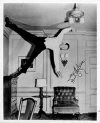Technique: The Ol' Revolving (or Tilted) Room Trick
Let's face it, special effects are cool and practical effects are even cooler. When you can pull of some cinematic skullduggery "live" with no post-production necessary, it's pretty nifty. One of my favorite examples of this is when the young Forrest Gump breaks out of his leg braces, and runs past the the camera. When the bullies pass, the camera pans to see Gump impossibly far ahead with a trail of dust in his wake--all in one unbroken shot. Awesome.
Another great (and as-old-as-the-hills) gimmick is the "revolving room". This involves a set with nailed-props placed in a circular "barrel" that can be turned. The camera is fixed on the same plane as the "floor", tricking the viewer into thinking this is "down". When the set turns, the actor appears to be walking on the walls, when in reality gravity is just doing its thing--it's the set and camera that are moving.
 This was most famously used in the Fred Astaire film, Royal Wedding (1951), when he performs a dance number literally all over the place (Lionel Richie did the same thing in his Dancing on The Ceiling music video 35 years later). Remember when Johnny Depp got turned into a milkshake in A Nightmare on Elm Street and his blood poured up out of the bed? Or when a mutant Jeff Goldblum ran up the wall in The Fly? The list is endless (anybody can do it), and it's all thanks to our friend the revolving room.
This was most famously used in the Fred Astaire film, Royal Wedding (1951), when he performs a dance number literally all over the place (Lionel Richie did the same thing in his Dancing on The Ceiling music video 35 years later). Remember when Johnny Depp got turned into a milkshake in A Nightmare on Elm Street and his blood poured up out of the bed? Or when a mutant Jeff Goldblum ran up the wall in The Fly? The list is endless (anybody can do it), and it's all thanks to our friend the revolving room.The most innovative use of this effect is when there is another person involved. It's easy to wrap your head around this idea when only one person is in the shot, but add another actor and it's freaky. In the featured example, you want to believe the actress is laying "down", right? The truth is, it is she (along with the set) that is at an angle, not the actor.
Comments